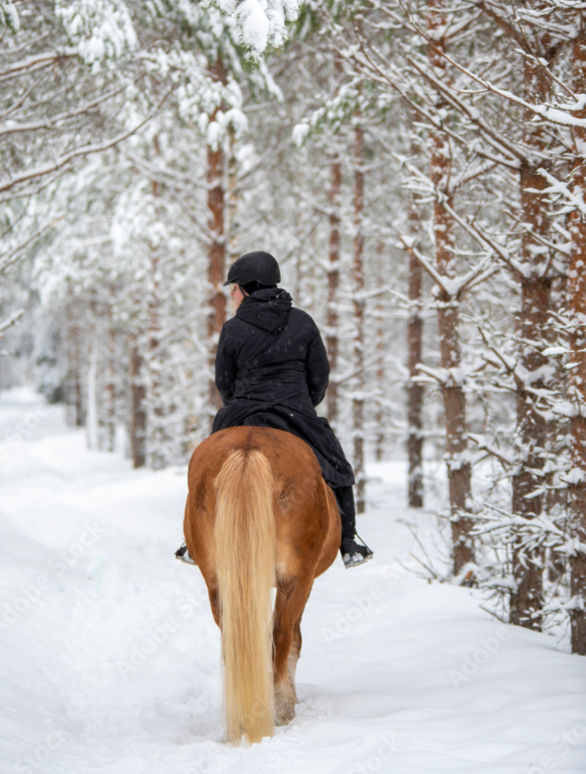Proper Winter Warm-Ups and Cool-Downs
- Twenty Four Carrots
- Feb 13
- 4 min read
Have you ever watched professional athletes before a big game? You’ll see them doing short runs, lunges, and a series of other dynamic warm-ups. It’s almost unheard of for an athlete — at any level — to jump straight into a game or a match without warming up first. That’s because cold, stiff muscles don’t perform well, and the risk of injury skyrockets! Well, horses are athletes too, and this surely applies to them too — especially in the colder months.
Keep reading to learn about how cold weather affects horses and the science behind proper warm-ups and cool-downs.
How Cold Weather Affects Horses
The cold can be tough on our equine friends. Their muscles and joints can become stiff, and blood flow slows down. That’s why warm-ups are essential, especially during winter months. Even more importantly, they help ease the body into motion and reduce the risk of strain.
The Science of an Effective Warm-Up
You should never skip a warm-up period, but when it’s cold out, it’s even more crucial! Imagine stepping outside on a freezing morning and immediately sprinting. That would feel awful, right? The same goes for your horse. Diving right into strenuous exercise with cold muscles is a lot to ask. Plus, it can lead to stiffness, soreness, and even injuries due to lactic acid buildup.
Why Warm-Ups are Non-Negotiable
Understanding how warming up can impact your horse’s biomechanics can help you fine-tune your routine for better performance and a reduced risk of injury. A proper warm-up increases your horse’s joint range of motion and muscle elasticity. They also help prevent strains and enhance the quality of their stride, allowing for better balance and cadence in the arena. 1

A slow and steady warm-up also enhances your horse’s oxygen intake, reducing their reliance on anaerobic pathways.This means horses use oxygen more efficiently, helping them sustain energy so they don’t tire out as quickly. 2
Skipping or rushing through warm-ups can increase the risk of lactic acid buildup, leading to muscle soreness, stiffness, and poor performance. And the colder it is, the longer it takes for muscles to warm up. Including a routine warm-up is critical for your horse’s health and well-being.
Warm-Up Tips
Walk for 10-15 minutes on a loose rein before starting work
Change directions and your track to keep your horse engaged
Activate the haunches with lateral work, such as leg yields and shoulder-ins
Gradually work up to trotting and cantering
If your horse feels stiff, extend the warm up
The Role of a Proper Cool-Down
Cool-downs are just as important as warm-ups! Think of it as a chance to connect with your horse after they’ve given you their all during your ride. Proper cool-downs help prevent muscle stiffness, aid recovery, and signal to their body that it’s time to slow down.
Why Cooling Down Matters
A gradual decrease in exercise helps reduce your horse’s heart rate before they move on to grooming, mealtime, or stall time. 3
Cooling down also helps regulate body temperature and flush out lactic acid from their muscles. And when lactic acid isn’t removed, soreness and muscle fatigue become more likely.
Winter is not the time to skip your cool down! Without a proper cool-down, you may find that your horse feels a bit stiff and uncomfortable the next day. Because it takes more time for horses to recover due to reduced blood flow, walking them out properly ensures their muscles recover smoothly and that they are ready to work again and feel their best the following day. 4
Cool-Down Tips
Walk for 10-15 minutes after your ride
Loosen the girth if you feel comfortable
Take a couple of loops around the barn to change things up
For extra cold conditions, use a cooler to prevent cold-induced muscle stiffness 4
Other winter cautions
There’s no doubt that winter requires extra caution when riding, both for your horse’s health and well-being. Here are a few more things to keep in mind:

Footing
Icy and wet conditions can create slippery footing. And improper footing is a recipe for disaster, greatly increasing the risk of injury! Always, always check the footing before your ride. If conditions are unsafe, consider using an indoor arena if available. If riding outside isn’t an option, you can always opt to hand walk your horse.
Conditions
Always monitor your horse before, during, and after your ride. If their gait is uneven, they may need more thorough warm-up, a day off or potentially a visit from the veterinarian. Pay close attention to their breathing — heavy breathing or reluctance to move could mean they’re overexerted in the cold.
Final Thoughts
Winter riding comes with unique challenges, but it’s nothing we equestrians can’t handle! It just means committing to a structured warm-up and cool-down routine after every ride.Taking the extra time to prepare and recover ensures your horse remains happy and healthy. So, commit to a proper routine year-round, and your horse will thank you for it!
Sources
Clayton, H. M., et al. (2007). "Biomechanical analysis of warm-up routines and their effects on equine performance."
Lindner, A., & Freund, W. (2002). "Effect of warm-up intensity on oxygen uptake and muscle metabolism in horses."
Evans, D. L., et al. (1993). "The role of cool-down in equine recovery and performance."
Forbes, T. J., & Watson, T. D. (1997). "Equine recovery strategies and their impact on performance."
Comments